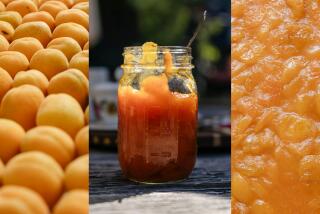Can All You Want, but Will You Eat All You Can?
- Share via
BOSTON — There’s something marvelous about canning--capturing the flavors of the season to enjoy later.
“Preserving at home is a natural outgrowth of America’s renewed passion for home favorites, less complicated dishes and quality, high quality, at any cost,” California jam-maker Edon Waycott writes in her book “Preserving the Taste” (Hearst Books, 1993).
That said, you’d better like whatever it is you’re canning--you may be eating it for years. You can send it to relatives, foist it off on co-workers, but chances are, there will still be rows of Mason jars staring at you whenever you peek in the pantry.
My family discovered canning when we moved to Massachusetts and bought a house with two apple trees in the front yard. One bumper crop later and we had exhausted recipes for apple pie, baked apples, apple cake, apple betty and apple pancakes. And still there were apples--in buckets, barrels and bags all over the kitchen.
In desperation my mom found a recipe for apple butter and simultaneously discovered canning rule No. 1: Patience. My mother stirred and stirred, but the mixture wouldn’t thicken. She added more apples and more sugar and more cinnamon. When it finally thickened, the apple butter was only slightly less dense than uranium and had to be sliced with a knife.
Two apple harvests later, I thought I’d try my hand at canning. I figured hovering over a pot of cinnamon and brown sugar for an evening couldn’t be too terrible. Everyone assured me the apple butter was delicious, but after stirring mushed apples for three hours, I had lost my appetite.
My husband created labels on the computer, and we mailed jars of apple butter to relatives all over the country, gave it to co-workers and still had a two-year (and counting) supply left.
There are no shortcuts to homemade apple butter. The recipe isn’t meant to be precise, so you have to be flexible and willing to do a lot of taste-testing. (Volunteers shouldn’t be hard to find, just make sure you sign them up for stirring detail.)
Batches of apples will vary in sweetness and juiciness, so you may need to vary the amount of sugar and cider. The butter should be dark in color and thick but spreadable.
*
STIR-CRAZY APPLE BUTTER
3 cups sweet apple cider
8 pounds tart, juicy apples such as Granny Smith or Pippin
3 cups brown sugar, packed
2 teaspoons ground cinnamon
1/2 teaspoon ground allspice
1/2 teaspoon ground cloves
1/4 teaspoon salt
Boil cider in large non-aluminum kettle until amount is reduced by 1/2, about 30 minutes.
Quarter and core apples but do not peel them. Add apples to reduced cider and cook over low heat until apples are tender, stirring almost constantly.
When apples are very soft, force mixture through sieve or strainer and return mixture to kettle.
Add sugar, cinnamon, allspice, cloves and salt and cook over low heat until mixture thickens, stirring constantly, about 30 minutes.
Pack apple butter in sterilized mason jars to within 1/2-inch of top. Seal with new lids and metal rings.
Process in hot-water bath for 15 minutes. Remove, cool and check seals before storing.
Makes 4 pints.
Each tablespoon contains about:
32 calories; 6 mg sodium; 0 cholesterol; 0 fat; 8 grams carbohydrates; 0 protein; 0.16 gram fiber.
*
SWEET LIME PICKLES
2 cups hydrated lime (available where canning supplies are sold)
Cold water
7 pounds cucumbers, sliced
3 3/4 pounds sugar
2 quarts white vinegar
3/4 cup celery seeds
2 teaspoons pickling spices
1 tablespoon salt
Few drops green food color
Sunny Bixby’s sweet lime pickle recipe came with the house she and her husband bought on a farm in upstate New York. “The lady who sold us the house gave us the pickle recipe,” Bixby says. The sweet pickles she now makes are a remarkable glowing green, as if they’d been colored with a Crayola marker (actually, a few drops of food coloring does the trick). They’re best when served on ham or turkey sandwiches. When Bixby cans, she usually makes a two-year supply. Her pickles are so popular that last year she made about 25 quarts.
Dissolve hydrated lime in 2 gallons cold water, stirring well until dissolved. Soak cucumber slices 24 hours in lime-water solution.
Drain and rinse cucumbers. Cover with cold water and let stand about 3 hours and drain again.
Combine sugar, vinegar, celery seeds, pickling spices, salt and food color, then pour over drained cucumbers and let stand 8 to 10 hours. Cook additional 25 to 30 minutes. Pack and seal in sterilized Mason jars.
Makes 9 pints, 72 (1/4-cup) servings.
Each 1/4-cup serving contains about:
7 calories; 99 mg sodium; 0 cholesterol; 0 fat; 2 grams carbohydrates; 0 protein; 0.12 gram fiber.
More to Read
Eat your way across L.A.
Get our weekly Tasting Notes newsletter for reviews, news and more.
You may occasionally receive promotional content from the Los Angeles Times.










